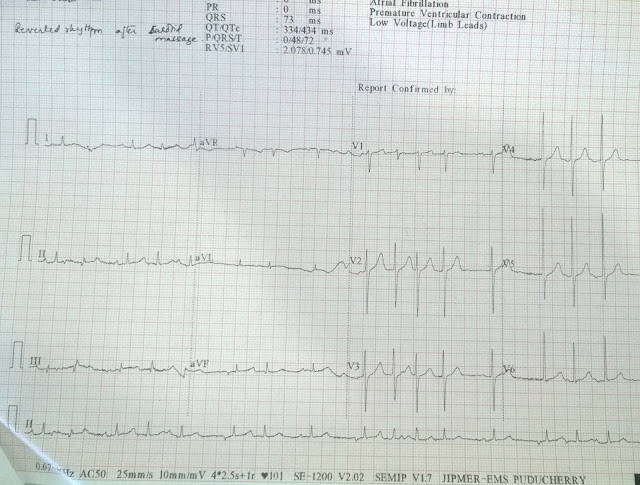A 76 years old male resident of Thiruvannamalai, Tamilnadu, came to JIPMER hospital Pondicherry with chief complaints of acute onset palpitation since last one hour, which was acute in onset, no associated with any chest pain, giddiness or vomiting. There was no history of diabetes mellitus, hypertension, coronary artery disease or smoking. During evaluation in the emergency department patient pulse rate was 190 beats per minute, BP-110/60 mmhg. ECG of the patient done in the emergency department, which is shown below.
ECG 1 (Click on the image to enlarge it)
Description of the ecg-Narrow QRS complex regular tachycardia with heart rate aound 190 beats per minute, P wave are negative in lead II, III,avF and there is Pseudo R wave seen in lead V1, QRS alternans is present, no other ST-T wave changes were present. RP interval 140 msec, PR interval 200 msec so the ecg is suggestive of Short RP tachycardia so the diagnosis is PSVT with differential diagnosis being AVRT first and AVNRT second.
Patient was given carotid sinus message and his rhythm converted to sinus rhythm.
Sinus ECG of the patient-Sinus rhythm at rate 120 beats per minute, normal axis, no ST-T wave changes seen.
Patient underwent electrophysiological study at JIPMER hospital which was suggestive of AVRT with concealed accessory pathway.
Lets see how to approach in a patient with Narrow QRS Complex tachycardia
Thank you.
ECG 1 (Click on the image to enlarge it)
Description of the ecg-Narrow QRS complex regular tachycardia with heart rate aound 190 beats per minute, P wave are negative in lead II, III,avF and there is Pseudo R wave seen in lead V1, QRS alternans is present, no other ST-T wave changes were present. RP interval 140 msec, PR interval 200 msec so the ecg is suggestive of Short RP tachycardia so the diagnosis is PSVT with differential diagnosis being AVRT first and AVNRT second.
Patient was given carotid sinus message and his rhythm converted to sinus rhythm.
Sinus ECG of the patient-Sinus rhythm at rate 120 beats per minute, normal axis, no ST-T wave changes seen.
Patient underwent electrophysiological study at JIPMER hospital which was suggestive of AVRT with concealed accessory pathway.
Lets see how to approach in a patient with Narrow QRS Complex tachycardia
Thank you.



No comments:
Post a Comment